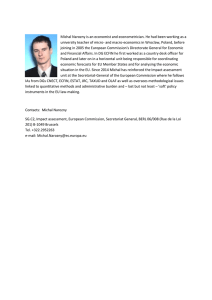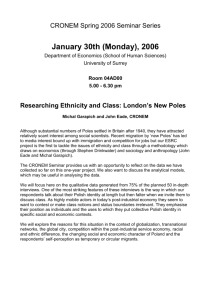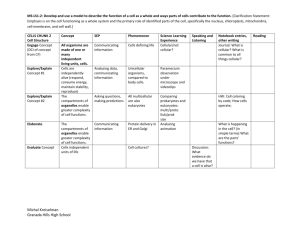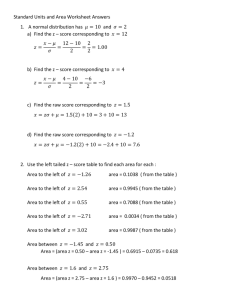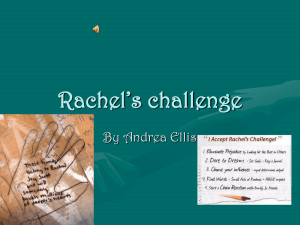may the lord make the woman like rachel
advertisement
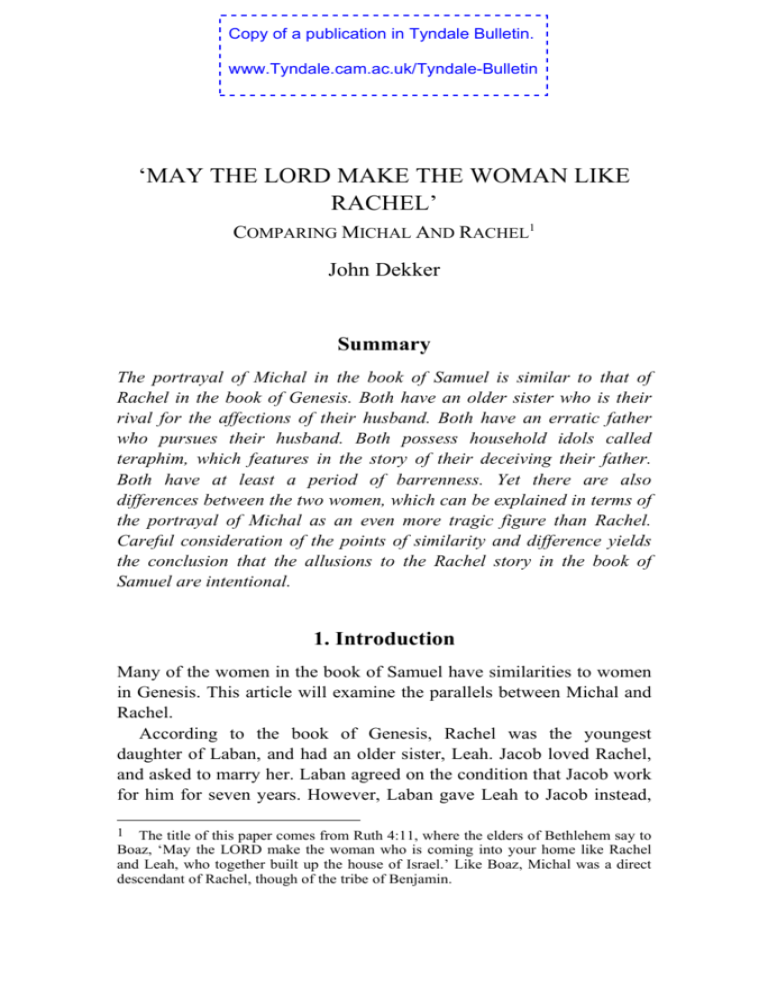
Copy of a publication in Tyndale Bulletin. www.Tyndale.cam.ac.uk/Tyndale-Bulletin ‘MAY THE LORD MAKE THE WOMAN LIKE RACHEL’ COMPARING MICHAL AND RACHEL1 John Dekker Summary The portrayal of Michal in the book of Samuel is similar to that of Rachel in the book of Genesis. Both have an older sister who is their rival for the affections of their husband. Both have an erratic father who pursues their husband. Both possess household idols called teraphim, which features in the story of their deceiving their father. Both have at least a period of barrenness. Yet there are also differences between the two women, which can be explained in terms of the portrayal of Michal as an even more tragic figure than Rachel. Careful consideration of the points of similarity and difference yields the conclusion that the allusions to the Rachel story in the book of Samuel are intentional. 1. Introduction Many of the women in the book of Samuel have similarities to women in Genesis. This article will examine the parallels between Michal and Rachel. According to the book of Genesis, Rachel was the youngest daughter of Laban, and had an older sister, Leah. Jacob loved Rachel, and asked to marry her. Laban agreed on the condition that Jacob work for him for seven years. However, Laban gave Leah to Jacob instead, 1 The title of this paper comes from Ruth 4:11, where the elders of Bethlehem say to Boaz, ‘May the LORD make the woman who is coming into your home like Rachel and Leah, who together built up the house of Israel.’ Like Boaz, Michal was a direct descendant of Rachel, though of the tribe of Benjamin. 18 TYNDALE BULLETIN 64.1 (2013) making Jacob work for him for another seven years in order to marry Rachel. When Jacob left Laban, Rachel stole her father’s teraphim, or household idols. The parallels with Michal in the book of Samuel are hard to miss. Michal loves a man (David) who is working for her father (Saul). She has a sister (Merab) who is also considered for marriage to this man. Saul pursues David, and Michal uses teraphim in order to help David escape. In this way, Saul is like Laban, David is like Jacob, Merab is like Leah and Michal is like Rachel. In this article, I will discuss the relationships that Michal has with Merab, David and Saul, and explore the intertextual links with Rachel’s relationship with Leah, Jacob and Laban respectively. This exploration will shed light on how Michal is portrayed in the book of Samuel. J. P. Fokkelman suggests that ‘an entire series of words and facts provides a foundation for a homology of Laban:Jacob:Rachel = Saul:David:Michal’.2 I will build on the work of Fokkelman, who discusses similarities and differences between Michal and Rachel found in 1 Samuel, but does not refer to Rachel in his treatment of Michal in 2 Samuel.3 Moreover, it will be seen that this homology can be extended to Laban:Jacob:Rachel:Leah = Saul:David:Michal:Merab. 2. Rival Sisters: Michal and Merab Just as Rachel had an older sister, Leah, so Michal has an older sister called Merab. We are introduced to Merab in 1 Samuel 14:49, where we are told she is the firstborn, and thus older than Michal, just as Genesis 29:16 indicates that Leah was older than Rachel. Merab next appears by name in 1 Samuel 18, which tells the story of David’s being betrothed to Merab, but at the last moment she is given to another: ‘when the time came for Merab, Saul’s daughter, to be given to David, she was given in marriage to Adriel of Meholah’ (1 Sam. 18:19). 2 J. P. Fokkelman, Narrative Art and Poetry in the Books of Samuel: A Full Interpretation Based on Stylistic and Structural Analyses. Volume 2: The Crossing Fates (Assen: van Gorcum, 1986): 274. 3 J. P. Fokkelman, Narrative Art and Poetry in the Books of Samuel: A Full Interpretation Based on Stylistic and Structural Analyses. Volume 3: Throne and City (Assen: van Gorcum, 1990): 198-205. DEKKER: Michal and Rachel 19 1 Samuel 17 also refers to an unnamed daughter of Saul. David is told that the king will give his daughter in marriage to the man who kills Goliath (1 Sam. 17:25). Now, this may have been merely a battlefield rumour, but it creates another parallel between David and Jacob. Just as Jacob had to pay two dowries for Rachel, (working seven years, and then another seven years (Gen. 29:27-28), so David pays, in effect, two dowries for Michal—the killing of Goliath, followed by the death of one hundred Philistines. Alternatively, we could view David’s acquisition of two hundred Philistine foreskins—twice the required number—as a parallel to Jacob’s double dowry. In the Genesis 29 narrative, Jacob wished to marry Rachel, but he is deceived on the wedding night, and finds himself married to Leah instead. Genesis 29:26 indicates that this was Laban’s doing, and that Jacob correctly identified it as deceit on Laban’s part. The story in 1 Samuel plays out differently. There is no deceit on Saul’s part, unless he allowed David to be betrothed to Merab when he had no intention of allowing them to marry. David does not end up marrying two women, and there is no switch on the wedding night. The narrative, however, allows for the possibility of a switch in men—Merab thinks she is going to marry David, but in fact is given to Adriel (1 Sam. 18:19). The NIV, NASB and NLT commence the verse with ‘So’, implying that it follows on from David’s question in verse 18, while the RSV, NRSV and ESV have ‘But’. However, David’s statement was not necessarily a refusal, and we get the sense that Saul is a capricious man, acting on a whim. There are parallels between the way in which Laban gave Leah and Rachel to Jacob and the way in which Saul offered Merab and then gave Michal to David. These parallels, however, are not exact. In the Genesis narratives, there is rivalry between Rachel and Leah. They are rivals for Jacob’s affection, and Genesis 29:30 says that Jacob loves Rachel more than Leah, a situation that leads to Yahweh opening Leah’s womb. Then Genesis 30:1 explicitly says that Rachel was jealous of Leah because she bore children. The names of Jacob’s sons in Genesis 30 indicate a continuing rivalry. For example, when Leah gives birth to Zebulun, she says, ‘This time my husband will treat me with honour, because I have borne him six sons’ (Gen. 30:20). Is there rivalry between Merab and Michal? We are not told why Merab was given to someone else. Norah Lofts suggests that, while it TYNDALE BULLETIN 64.1 (2013) 20 may have been sheer spite on Saul’s part, perhaps ‘Michal had a hand in the business.’ After all, ‘she was, as the later events in the story prove, a crafty and resourceful woman’.4 Hence, even in 1 Samuel 18 a parallel is made between Michal and Rachel. She has an older sister who is also offered in marriage. Brueggemann, however, argues that the parallelism is not germane, because ‘Merab is not accepted in these verses as David’s wife.’5 Yet this would certainly enable us to make sense of the inclusion of the Merab story. Thus, we see that the first correspondence between Rachel and Michal is that they both have a sister, and that this sisterly relationship is important to the plot of their respective stories. 3. Love and Marriage: Michal and David 3.1 Love and Beauty Like Sarah and Rebekah before her, Rachel is described as being beautiful. Michal, however, is not—the narrative is silent on this point. In fact, the rabbinic tradition fills in what the biblical text is lacking, and does suggest that Michal was beautiful. Louis Ginzberg says that she was ‘of entrancing beauty’.6 It seems that the rabbis went out of their way to establish Michal’s beauty, which is what we might have expected the biblical narrative to say. However, this merely highlights the fact that the text does not say it. Michal is said to love David, but nowhere does the narrative tell us that David loves Michal. In fact, the contrary may even be suggested. The first thing we are told about Michal, in 1 Samuel 18:20, is that she loved David. This is the only time in the Hebrew Bible that a woman is said to love a man.7 It appears that everyone loves David. In verse 1, it 4 Norah Lofts, ‘Michal’ in Women in the Old Testament: Twenty Psychological Portraits (London: The Religious Book Club, 1950): 112. 5 Walter Brueggemann, ‘Narrative Coherence and Theological Intentionality in 1 Samuel 18’, CBQ (1993): 233. 6 Louis Ginsberg, The Legends of the Jews, Vol. 4. Available at http://-philologos.org/__eb-lotj/--vol4/-p04.htm [accessed 2 May 2013]. This comes from b.Megillah 15a, which lists the biblical women ‘of surpassing beauty in the world’, including Michal, but strangely not Rachel. Available at http://-www.halakhah.com/-pdf/-moed/Megilah.pdf [accessed 2 May 2013]. 7 Robert Alter, The David Story (New York: W. W. Norton & Co., 2000): 115. DEKKER: Michal and Rachel 21 is said that Jonathan loved David, while in verse 16 ‘all Israel’ loves David. David Firth argues that although the romantic aspect cannot be excluded, ‘political loyalty dominates the other expressions of love for David, and it is most likely that Michal’s attitude functions in the same way’.8 Verse 16 gives a reason why all Israel loved David—it is that he ‘went out and came in before them’.9 This refers to David’s fighting battles on Israel’s behalf. It appears that the people’s loyalty stemmed from admiration and gratitude, and that all of these aspects can be summed up in the word ‘love’. Although the text does not explicitly give a reason as to why Michal loved David, and a range of suggestions have been made,10 the rationale of admiration and gratitude could quite easily apply to Michal also. 1 Samuel 18 describes an offer being made to David to become the king’s son-in-law. This is said to have pleased David (verse 27). The verb ישׁרis used in verse 20 as well as verse 26. It seemed good to Saul that Michal loved David, and it seemed good to David to become Saul’s son-in-law. Yet there is no indication that David loved Michal or desired to marry her ‘for herself’. The passage indicates a conspiracy between two men, with Michal being merely a pawn in the negotiations. Saul is using Michal’s love for his own ends, while David appears to be more interested in the high position that marriage will bring. Hence, the story of David and Michal differs markedly at this point from that of Jacob and Rachel. However, Lawton suggests that the use of this correspondence actually tends to highlight David’s lack of love for Michal: Why would the “author” want the reader to think about Jacob, Leah, and Rachel? Is there, in fact, a parallel? After all, Jacob loves Rachel. But that is the point. Aware of the parallel, the reader expects to learn that David “loves” Michal. And yet that is what the reader does not hear. The 8 9 David G. Firth, 1 & 2 Samuel (Nottingham: Apollos, 2009): 211. The Hebrew particle כִּיis here almost certainly causal. The NIV and NKJV render the word as ‘because’, while the ESV and RSV have ‘for’. The NASB, on the other hand, translates it as ‘and’. 10 See Clines, ‘Michal Observed: An Introduction to Reading Her Story’ in Telling Queen Michal’s Story: An Experiment in Comparative Interpretation, ed. David J. A. Clines and Tamara C. Eskenazi (JSOTS 119; Sheffield: Sheffield Academic Press, 1991): 33, for a range of suggestions. 22 TYNDALE BULLETIN 64.1 (2013) narrator tells us that ‘Saul’s daughter Michal loved David’ (1 Sam 18:20), but there is no mention of David’s loving her.11 3.2 Confrontation and Barrenness Both Rachel and Michal have a confrontation with their husbands that is recorded in the biblical text, and in both cases a connection is made with barrenness. The barrenness of Rachel in the book of Genesis is famous. Genesis 29:31 says that ‘when Yahweh saw that Leah was unloved, he opened her womb; but Rachel was barren’. It does not explicitly say that God ‘closed’ Rachel’s womb, but that is the clear implication. The following chapter describes a confrontation between Rachel and Jacob. She says to him, ‘Give me children, or I die!’ (Gen. 30:2), while he responds, ‘Am I in the place of God, who has withheld from you the fruit of the womb?’ H. C. Leupold suggests that ‘Jacob’s anger is justifiable, for his wife has given vent to a foolish and sinful utterance’,12 but Leupold also agrees with Keil’s comment that Jacob lacked the capacity to pray for his wife, as Isaac had done in Genesis 25:1.13 It is not until much later that ‘God remembered Rachel, and God listened to her and opened her womb’ (Gen. 30:22). Rachel conceives and gives birth to Joseph (Gen. 30:23). Later still, in chapter 35, we are told that she ‘laboured in childbirth’ (Gen. 35:16)—though we had not been told that she had conceived—before she dies giving birth to Benjamin. There is great irony here, of course, in that the woman who said ‘Give me children, or I die!’ dies in childbirth. In Michal’s case, the confrontation occurs prior to any mention of barrenness. It is recorded in 2 Samuel 6. This chapter records the incident of David’s bringing the ark into Jerusalem and dancing before it. The narrative indicates approval of David’s actions. The fact that David, unlike Uzzah, does not get struck dead, as well as the repeated phrase ‘before Yahweh’ (verses 14, 16 and 20) mean that Michal is in 11 Robert Lawton, ‘1 Samuel 18: David, Merob, and Michal’, CBQ 51 (1989): 424- 25. 12 H. C. Leupold, Exposition of Genesis, Volume II (Grand Rapids: Baker, 1960): 805. 13 Interestingly, the Bereishis Rabbah also notes that Jacob does not follow Isaac’s example here, but contends that it was inappropriate for Jacob to pray since Rachel, unlike Rebekah presumably, was by nature sterile. Yisrael Herczeg, ed., Saperstein Edition Rashi: The Torah with Rashi’s Commentary Translated, Annotated and Elucidated (Brooklyn, NY: Mesorah Publications, 2005): 329. DEKKER: Michal and Rachel 23 the wrong when she condemns him, even though the narrator does not say this explicitly. Michal accuses David of undignified behaviour. He was wearing (merely) a linen ephod (2 Sam. 6:14). J. Cheryl Exum suggests that the real issue is not David’s attire, but the kingship.14 David Clines disagrees, and argues it is David who would like the altercation to be regarded as ‘a conflict between the king that is and a representative of the king that was’. Clines goes on to suggest that Michal’s disgust was sexual: ‘She cannot bear to see the man she has loved flaunt himself as sexually available—presumably, that is, to anyone but her.’15 G. P. Hugenberger asserts that ‘David detected in Michal’s rebuke an underlying bitterness that God has so established a dynasty for David rather than her father.’16 Clines takes issue with this comment, and argues that ‘underlying dynastic bitterness’ is not the key to understanding the passage.17 Yet this is David’s assessment of Michal’s motives and feelings. He thinks that Michal is bitter. It is possible that David is jumping to conclusions. Of course, it could be that all these factors—clothing, kingship, sexuality, and also the factor of worship—are present and intertwined. We must reject Anthony Phillips’ hypothetical reconstruction that ‘David was evidently engaged in a ritual dance which may well have been intended to culminate in sexual union with Michal’,18 and that ‘as a loyal Yahwist’, Michal ‘took exception to the king’s participation in a ritual no doubt associated with the Jebusite cultus in Jerusalem’.19 Instead, Michal did not share David’s exuberance in worship. Is there any comparison between Rachel and Michal at this point? Both women are portrayed as being in the wrong in their confrontations with their husbands. In Rachel’s case, the dialogue follows her barrenness, which is later reversed. Michal is not, it seems, described as having any children. At the end of the confrontation between Michal 14 J. Cheryl Exum, ‘Murder They Wrote: Ideology and the Manipulation of Female Presence in Biblical Narrative’ in Telling Queen Michal’s Story, 161. 15 David J. A. Clines, ‘The Story of Michal, Wife of David, in Its Sequential Unfolding’ in Telling Queen Michal’s Story, 138. Emphasis original. 16 G. P. Hugenberger, ‘Michal’ in International Standard Bible Encyclopedia, ed. G. W. Bromiley (Grand Rapids: Eerdmans, 1986): III:348. 17 Clines, ‘Michal Observed’ in Telling Queen Michal’s Story, 53. 18 Anthony Phillips, ‘David’s Linen Ephod’, VT 19 (1969): 485. 19 Phillips, ‘David’s Linen Ephod’, 487. 24 TYNDALE BULLETIN 64.1 (2013) and David in 2 Samuel 6, it says that ‘Michal, daughter of Saul, had no child to the day of her death’ (6:23). This does not necessarily imply Michal’s childlessness is a result of the confrontation—the statement is connected to what precedes it simply with the word ‘and’.20 Indeed, the passage is magnificent in its ambiguity, even to the point of making us wonder if Michal had children on the day of her death—if, in other words, she, like Rachel, died in childbirth. This is, in fact, the suggestion given in the Numbers Rabbah 4:20.21 Whether or not this is the case, Michal takes her place among the barren women of Scripture. If we do not adopt the above interpretation, then we are forced to conclude that, unlike all the other barren women, Michal never conceives. Moreover, with all these other women the mention of their barrenness comes at the start of each story, while with the story of Michal there is a stunning inversion—her barrenness comes at the end. This is an example of reversal of fortune, a key motif in the book of Samuel.22 Along with the whole house of Saul, Michal experiences a great fall. As far as the narrative of 2 Samuel goes, this sets up the covenant with David established in the following chapter. There is one more point of ambiguity to consider, this time a textual one. After the statement of 2 Samuel 6:23, Michal’s name is mentioned once more in the Masoretic Text, in 2 Samuel 21:8. This verse refers to the ‘the five sons of Merab the daughter of Saul, whom she bore to Adriel the son of Barzillai the Meholathite’ (ESV). Although many scholars follow the two medieval Hebrew manuscripts which read it as ‘Merab’, the Masoretic Text reads ‘Michal’. This is evidently the more difficult reading, since it says that she had five children, whereas 2 Samuel 6:23 indicated that Michal was childless. Ben-Barak notes that if there is a mistake in this verse, it is not necessarily with Michal’s name, but could be in the name of her husband.23 H. J. Stoebe suggests that Adriel and Paltiel are the same name, as Adriel is an Aramaic name with the same meaning as Paltiel: ‘God is the Saviour.’24 Perhaps 20 Alter notes that there is here a ‘suppression of causal explanation’. Alter, The David Story, 230. 21 Tamara C. Eskenazi, ‘Michal in Hebrew Sources’ in Telling Queen Michal’s Story, 159. 22 Firth, 1 & 2 Samuel, 42. 23 Ben-Barak, ‘The Legal Background to the Restoration of Michal to David’ in Studies in the Historical Books, ed. J. A. Emerton (VTSup 20; Leiden: Brill, 1979): 27. 24 Cited in Ben-Barak, ‘Legal Background’, 27. DEKKER: Michal and Rachel 25 we could interpret 2 Samuel 6:23 as saying that Michal had no more children, but had five already, presumably with Paltiel. It can be seen then, that these episodes in the life of Rachel and Michal have their own parallels. Both women have a period of barrenness. Both have a significant confrontation with their husband,25 in which the women are largely to blame, although their husbands might not be altogether faultless. Rachel’s confrontation eventually leads to conception and giving birth, while Michal’s is very much the end of her story. 4. Deceiving Dad: Michal and Saul The most obvious parallel between Michal and Rachel is their possession of teraphim, and their use of them in deceiving their fathers. In 1 Samuel 19, Michal helps David to escape from Saul by letting him out through a window. She is described as ‘David’s wife’, highlighting that in this passage she is acting for David. When Saul’s messengers come for David, she says that he is sick, and places teraphim in the bed as a ruse. This incident in 1 Samuel 19 is calculated to remind the reader of Rachel, wife of Jacob. According to Genesis 31, Rachel stole the teraphim from her father Laban when she fled with Jacob, and when Laban came to look for them, she put them under her and claimed that she could not get up because she was having her period. It appears that we have here two stories where the presence of teraphim is connected to deceiving one’s father and the escape of one’s husband. In verse 13, Michal takes one of the teraphim and places it on the bed. It appears that Michal uses it as a ruse in order to buy David some time. The incident demonstrates her ingenuity: she puts a net of goats’ hair at its head and covers it with clothes, in order to give the illusion of a sleeping form. The incident also suggests loyalty to David, even if it means incurring the displeasure of her father. Klein points out that 25 Chaya Ben-Ayun has recently written an article in Hebrew, ‘Between Michal and Rachel—Reflection of Misery’ (Beit Mikra 175 (2003): 289-301) which argues that Michal is the ‘antithesis of Rachel, the beloved wife’. Ben-Ayun focuses on the two confrontations both women have: with their fathers and with their husbands. 26 TYNDALE BULLETIN 64.1 (2013) like God, Michal chooses David over Saul.26 However, both this loyalty and the ingenuity are tempered by the fact that Michal is deceitful. Not only is the teraphim ruse calculated to deceive her father, but she lies outright in saying that David is sick (verse 14), and then besmirches David’s character by saying that he threatened her. However, the lie is not condemned in the text. Leithart argues that the lie was not a sin, but ‘an act of loyalty to Yahweh and His future king’.27 Whereas Michal deceives her father in order to help her husband escape, with Rachel the motivation seems purely self-interest. Victor P. Hamilton states that unlike Rachel, ‘Michal acted out of loyalty to her husband and concern for his safety.’28 Hamilton refers to 1 Samuel 19:11, where Michal says to David, ‘If you do not escape with your life tonight, tomorrow you will be killed.’ Fokkelman also sees a great difference between Michal and Rachel at this point, and suggests that while Rachel’s action was ‘no less than a capital crime’ and puts other lives at risk, Michal ‘reacts solely to the risk of life created by the king’.29 However, it must be noted that Michal is also protecting herself. The way that she smears David’s character by saying that he threatened her indicates that her motives are not entirely pure. The use of teraphim must also be seen to be idolatrous. Just a few chapters earlier, it had received prophetic disapproval when Samuel had told Saul that ‘presumption is iniquity and idolatry’ (1 Sam. 15:23). This line parallels the one previous: ‘rebellion is the sin of divination’. Yet the word ‘idolatry’ here is simply תְּרָ פִים. Although the point of Samuel’s speech is that rebellion is just as bad, this denounces the use of the teraphim, as well connecting them with divination. In fact, we could say that the book of Samuel portrays Michal as being virtually irreligious. Not only does she use teraphim, lie and deceive in 1 Samuel 19, but in 2 Samuel 6 Michal frowns on David’s worship. Klein views Michal’s barrenness, noted in 2 Samuel 6:23, as connected to her use of the teraphim, that she is ‘portrayed as 26 Lillian Klein, ‘Michal, the Barren Wife’ in From Deborah to Esther: Sexual Politics in the Hebrew Bible (Minneapolis: Fortress Press, 2003): 87. 27 Peter J. Leithart, A Son to Me: An Exposition of 1 & 2 Samuel (Moscow, ID: Canon Press, 2003): 118. 28 Victor P. Hamilton, The Book of Genesis, Chapters 18–50 (NICOT; Grand Rapids: Eerdmans, 1995): 303. 29 Fokkelman, Narrative Art and Poetry in the Books of Samuel, Volume 2: 275. DEKKER: Michal and Rachel 27 barren of belief in the God of Israel, the God who could open her womb’.30 We must still consider the question of the ownership of this teraphim. The definite article is used in 1 Samuel 19:13— הַתְּרָ פִים. Van der Toorn says of the net of goats’ hair in this passage that the ‘definite article indicates that it was an object normally to be found in an Israelite household’,31 and the same would surely apply to the definite article here. The narrative does not say whether it belonged to Michal, or David, or both, but it is certainly present in David’s home. In accordance with his theory of the teraphim being an ancestor figurine, van der Toorn argues that ‘there is no hint of indignation’ in the passage over its presence in David’s home, and that their possession ‘did not strike many ancient Israelites as an incongruency’.32 In Rachel’s story, we do not have this ambiguity regarding the ownership of the teraphim. They belong to Laban, and are stolen by Rachel (Gen. 31:19). The narrator tells us in Genesis 31:32 that Jacob did not know anything about the theft. It is possible that the teraphim are referred to in Genesis 35:2, when Jacob tells ‘his house and all who were with him’ to ‘put away foreign gods’. It would seem Rachel does so (Gen. 25:4), although we have no mention of Michal getting rid of her idols.33 It would appear that the teraphim in the two stories are different. In Rachel’s case, it appears small enough to sit on, while in Michal’s case it is possibly as large as a human, since it is used as a ruse to make Saul’s men think that David is in bed. However, the text does not actually say that the men were deceived—verse 16 is probably the first time the messengers entered the room. Pamela Tamarkin Reis even suggests that they may have been the same object—she notes that the word ‘upon the bed’ in 1 Samuel 28:23 is only used of Saul, Michal, and Jacob, the latter occurrence being in Genesis 49:33. Reis suggests that Benjamin may have taken possession of the teraphim stolen by his mother, and that they were handed down the family to Saul and then to 30 Klein, ‘Michal, the Barren Wife’, 92-93. 31 Karel Van Der Toorn, ‘The Nature of the Biblical Teraphim in the Light of Cuneiform Evidence’, CBQ 52 (1990): 207. 32 Van Der Toorn, ‘Nature of the Biblical Teraphim’, 216. 33 Klein, ‘Michal, the Barren Wife’, 92. TYNDALE BULLETIN 64.1 (2013) 28 Michal.34 This fits well with the occurrence of the word in 1 Samuel 15:23, where Samuel denounces the use of the teraphim to Saul. It is, however, pure speculation that does not account for the fact that, according to Genesis 25:4, Rachel got rid of her idols. Hence, the incidents of the teraphim serve to connect Michal and Rachel. There are other similarities in the stories, as well. As Adin Steinsaltx points out, in both cases the teraphim are a ‘means of cheating the father’, and the ‘inner motive is similar: the bond with the man, with the new hero, is so deep that it apparently erases all other ties’.35 5. Death and Burial The death of Rachel is significant, and her burial place is noted as being ‘on the way to Ephrath’ and is marked with a pillar (Gen. 35:1920). Michal, on the other hand, like all the women of Samuel, simply fades out of the narrative. Her death is hinted at in 2 Samuel 6:23, but no indication is given of when it occurred. When Rachel steals the teraphim, she suffers a curse (Gen. 31:32). Does this lead to her death in childbirth? The text does not tell us. Yet Alter points out that the mention of the teraphim in 1 Samuel 19 may be intended to ‘foreshadow a fatality shared by Michal with Rachel, who becomes the object of Jacob’s unwitting curse because of the theft’.36 6. Evaluation 6.1 Assessing Allusions We see, then, that there are deep similarities between the biblical stories of Michal and Rachel. Are these allusions intentional? That is, 34 Pamela Tamarkin Reis, ‘Eating the Blood: Saul and the Witch of Endor’ in Reading the Lines: A Fresh Look at the Hebrew Bible (Peabody, MA: Hendrickson, 2002): 160-61. 35 Adin Steinsaltx, ‘The Princess and the Shepherd’ in Biblical Images: Men and Women of the Book (New York: Basic Books, 1984): 148. 36 Robert Alter, Art of Biblical Narrative (New York: Basic Books, 1981): 120. DEKKER: Michal and Rachel 29 are we meant to think of Rachel when we read about Michal? How do we know that the common points are not merely co-incidental? As mentioned above, J. P. Fokkelman discusses a number of correspondences between Michal and Rachel. Some of the correspondences Fokkelman mentions are slight, such as the verb מלא (‘complete’) in Genesis 29:21 and 1 Samuel 18:26, while others are much more significant, such as the question ‘Why have you deceived me?’ ( רמִּיתָנ ִי ִ )לָמָּה, which is found in Genesis 29:25 and 1 Samuel 19:17, and only one other place in the Hebrew Bible, 1 Samuel 28:12. Moreover, Fokkelman rejects as irrelevant a number of differences between the narratives of Rachel and Michal, such as the fact that Jacob was in a foreign country, but David was not.37 The number, specificity and importance of the points all indicate that the allusions are intentional. Firstly, we have seen that there are not merely one or two items of correspondence between Michal and Rachel, but several. The presence of an older sister, the pursuit by a father, an incident with teraphim, barrenness and being married to the hero of the story all combine to suggest this is not coincidental. Secondly, the correspondences are specific in that the teraphim do not appear many times in the Hebrew Bible. There are only three stories which feature teraphim, the other one being in Judges 17–18. Teraphim are mentioned a few other times (Exod. 21:26, 2 Kgs 23:24, Hos. 3:4 and Zech. 10:2) but this relative scarcity of references suggest intentionality. Thirdly, the correspondences are important in that they include matters intrinsic to the plot and characterisation. The story would fall apart if there had been no teraphim. At this point, it will be helpful to draw on the work of Paul R. Noble. In an article about the story of Judah and Tamar, Noble discusses the criteria by which intertextual resemblances can be identified as genuine, intentional allusions of one text to another.38 Building on the work of Robert Alter, Noble focuses on literary motifs and suggests that one passage is allusive of another if they have a number of motifs in common and the absence of motifs can be satisfactorily explained.39 37 Fokkelman, Narrative Art and Poetry in the Books of Samuel, Volume 2: 274. 38 Paul R. Noble, ‘Esau, Tamar, and Joseph: Criteria for Identifying Inner-Biblical Allusions’, VT 52.2 (2002): 220. 39 Noble, ‘Esau, Tamar, and Joseph’, 237. 30 TYNDALE BULLETIN 64.1 (2013) For us to be able to conclude that the story of Michal is intentionally allusive of Rachel’s story, the ‘type-narrative resemblances’ should ‘form an interconnected pattern’ (rather than ‘random scattering of individual, unrelated similarities’40) as well as ‘carry substantial meanings at the level of narrative detail’.41 This means that the ‘typenarrative resemblances’ should be an integral part of the story. That is what we see with the narrative about the teraphim—if it were not there, the story would be significantly changed. Saul is like Laban, David is like Jacob, Merab is like Leah and Michal is like Rachel. Yet it does not fit exactly. Unlike Leah’s marriage to Jacob, Merab did not actually marry David. Unlike Rachel escaping from Laban, Michal did not escape from Saul. Yet these differences are also significant. It is significant both to the story and to the character and fate of Michal that she did not go with David. How, then, do we explain the differences between Michal and Rachel? How do we account for the negative parallels? In the case of Michal, the points of difference to Rachel can be viewed as being the point of the story. She is unlike Rachel in that her sister does not marry her husband also. She is unlike Rachel in that her husband does not love her. She is unlike Rachel in that she does not escape with her husband. And she is unlike Rachel in that (according to the most likely reading of 2 Sam. 6:23), she remains barren all her life. The first point of difference possibly indicates that Saul is an even more erratic figure than Laban (in that he withholds Merab for no apparent reason). Having such an erratic father makes life difficult for Michal, and—like Rachel—she is forced to choose between loyalty to her husband and loyalty to her father. But all these points of difference indicate that Michal is a much more tragic figure than Rachel. She spent her life unloved by her husband. She spends the period of David’s wandering away from him and married to another. She is childless to the end of her days. It is significant both to the story and to the character and fate of Michal that she is unlike Rachel at these crucial points. We can, in fact, view Michal’s fate as being bound up in that of her father. She shares the tragedy of her family. J. Cheryl Exum notes that Michal plays ‘a minor but significant role in the tragedy of 40 Noble, ‘Esau, Tamar, and Joseph’, 244. 41 Noble, ‘Esau, Tamar, and Joseph’, 246. DEKKER: Michal and Rachel 31 Saul’s house’42 and suggests that ‘Saul’s house is fated, and none of its members remain untouched by tragedy.’43 Yet, while we may have sympathy for Michal, she also falls short of the standard set by the wives of the patriarchs. Even though Rachel stole her father’s teraphim, it appears that she got rid of them. The argument Rachel has with Jacob is resolved in a way that Michal’s argument with David is not. Rachel goes with Jacob when he escapes from Laban, while Michal does not go with David. The parallels, then, may help us to evaluate the character of Michal. The comparison with Rachel suggests that the narrator is not merely reporting the facts of the story without moral evaluation—he may well want us to think that Michal should have gone with David when he escaped from Saul. 6.2 Reasons for the Allusions We must ask why the Michal story is told in such a way as to highlight the correspondences with Rachel. One possibility is that the narrator wishes to emphasise the correspondences between David and Jacob. David is like another patriarch, a founding father of the nation. In making Michal look like Rachel, the narrator is suggesting to us that David is a new Jacob. Lyle Eslinger discusses traditional Jewish and Christian responses to seeing allusions in Scripture. The former is that it shows the fullness of Torah, the latter ‘revealed the hand of providence mapping out a course to the conclusive redemptive event’.44 Eslinger rejects both of these readings as ‘expressions of a particular religious community’, suggesting that they are ‘not serious guides to the biblical authors’ intent’.45 Yet we could see the allusions as part of the overall biblical story. The events of Genesis are recapitulated again and again in salvation history, as the Hebrew Bible follows its particular trajectory. 42 J. Cheryl Exum, Arrows of the Almighty: Tragic Dimensions of Biblical Narrative (Cambridge: Cambridge University Press, 1996): 81. 43 Exum, Arrows of the Almighty, 94. 44 Lyle Eslinger, ‘Inner-biblical Exegesis and Inner-biblical Allusion: The Question of Category’, VT 12 (1992): 47. 45 Eslinger, ‘Inner-biblical Exegesis’, 48. 32 TYNDALE BULLETIN 64.1 (2013) 6.3 Conclusion Michal is portrayed in ways similar to that of Rachel in the book of Genesis. Both have an older sister who is their rival for the affections of their husband. Both have an erratic father who pursues their husband. Both possess household idols called teraphim, which features in the story of their deceiving their father. Both have at least a period of barrenness. Yet there are also differences between the two women, which can be explained in terms of the portrayal of Michal as an even more tragic figure than Rachel. We conclude that we are meant to think of Rachel when we read about Michal.
